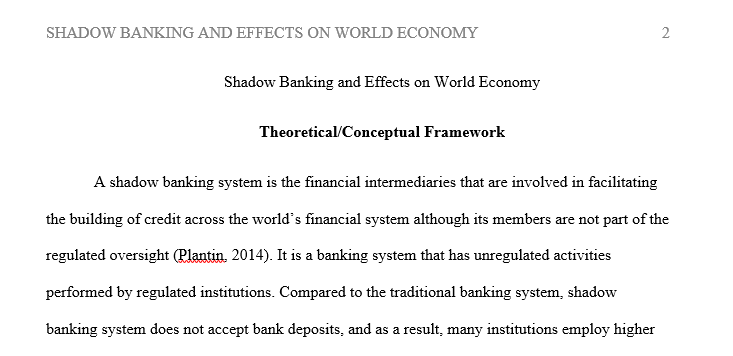
Theoretical/Conceptual Framework on shadow banking and effects on world economy
Theoretical/Conceptu
rewrite and increase the Theoretical/Conceptual Framework below by two pages to a total of 3 pages. following the requirements listed.
☐ Describe the guiding theoretical/conceptual framework of the study, including the definitions of all the concepts, an explanation of the relationships among the concepts, and a presentation of all the assumptions and propositions.
☐ Explain the origin and development of the framework. Demonstrate detailed knowledge of and familiarity with both the historical and the current literature on the framework.
☐ Identify existing research studies that used this framework in a similar way. Mention alternative frameworks, with a justification of why the selected framework was chosen.
☐ Describe how and why the selected framework relates to the present study and how it guided the development of the problem statement, purpose statement, and research questions.
key factors to be added and described
maturity transformation: obtaining short-term funds to invest in longer-term assets;
liquidity transformation: a concept similar to maturity transformation that entails using cash-like liabilities to buy harder-to-sell assets such as loans;
leverage: employing techniques such as borrowing money to buy fixed assets to magnify the potential gains (or losses) on an investment;
credit risk transfer: taking the risk of a borrower’s default and transferring it from the originator of the loan to another party.
banking licenses; depository bank, hedge funds, structured investment vehicles, special purpose entity conduits, money market funds, repurchase agreement, non-bank financial institutions, money market funds
APA style
Theoretical/Conceptual Framework
The shadow banking system comes out as a financial system that is heavily regulated and monitored, but has numerous differences in regulation and requirements, when compared to traditional formal banking system. Each country’s financial system is a economic contributor in the financial market is given a consideration for their population and contribution to the overall performance and existence of financial services in the economies of the countries in this study (Valdez & Molyneux, 2015). The conceptual aspect of the relationship between the formal banks and the shadow banking institutions is that the formal banks from the group of big players in the shadow banking works through their provision of services such as collateral to other players in the financial market environment. The big banks in the traditional banking group obtain their funding from money market funds while the shadow banking environment has the OTC its integral components, especially the derivatives (Carpenter & Whitelaw, 2016). The shadow banking institution depends on pledged collateral which indicates the domineering attributes of the formal banks in the shadow banking arena.
One theory suggested by Shadow banks is directly connected to the financial crisis of 2007-2009. We review these theories for shadow banking and their subsequent sources including asset-backed commercial paper (ABCP), tri-party repurchase agreements (repos), money market mutual funds (MMMFs), and securitization. To quote Joseph Schumpeter ‘only two theories of money which deserve the name…the commodity theory and the claim theory. From their very nature, they are incompatible’. Schumpeter’s view is still relevant. The commodity theory of money, reaffirmed in Kiyotaki and Wright (1989, 1991) is still significant. It treats currency as way of exchange, and has minor concentration in outlining the changing aspects of monetary spaces. But in comparison, the claim approach devised by Ingham treats currency as ‘social relation of debt and credit denominated in a unit of account’ (Ingham, 2004). Currency exemplifies a potential to accept another’s obligation (Lavoie 2014), with the
utmost reliability, and the broadest tolerability. Stephanie Bell-Kelton suggested to approach promises to pay through a hierarchy (or order) of tolerability. Currency would sit at the top of the pyramid, trailed by bank funds, the debt of organizations and of homes. The space from the top signifies the changing grade of suitability, basically contingent on how eagerly exchangeable private promises are into currency or in moneys higher in the hierarchy deprived of loss of value (at par on demand) (Wray 1990)
The traditional banking process gets challenged by the expansion of the shadow bank population. The theoretical implications of such a scenario are that banks would not be in the best position to create money out of nothing, as is usually the purported insinuation (Valdez & Molyneux, 2015). The theoretical aspects of the whole field of banking are that funding and market liquidity support development and a creation of asset markets and credit. The speed of disappearance of the market liquidity is also a significant idea to consider for the process of avoiding liquidity spiral in the financial market environment. The liquidity aspects of the global financial market get the directly correlated function of the interactive response between banking institutions and the shadow banks (Rey, 2015). Another conceptual perspective to the interaction between the banking and non-banking institutions is that the shadow banking system forms the driving engine that propels the entire financial market on a global scale. That seems to contradict the assertion concerning the friction between the two sides of the financial market that could result in economic jeopardy of the involved nations.
Answer Preview…………….

APA 1372 words